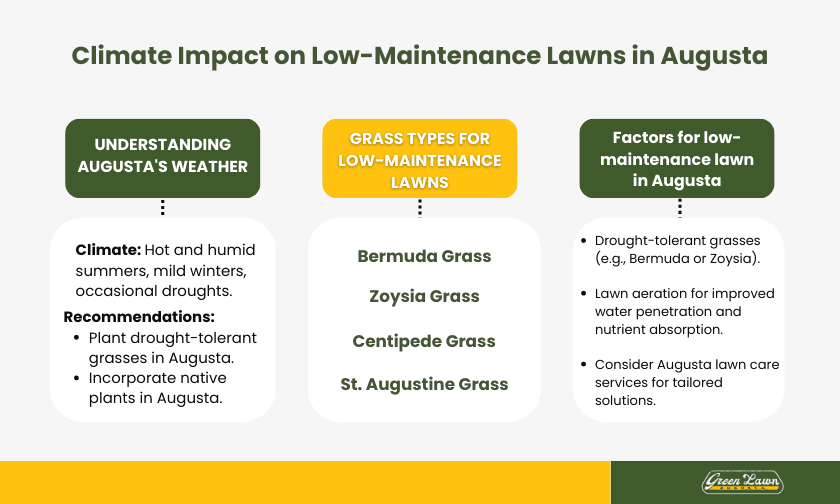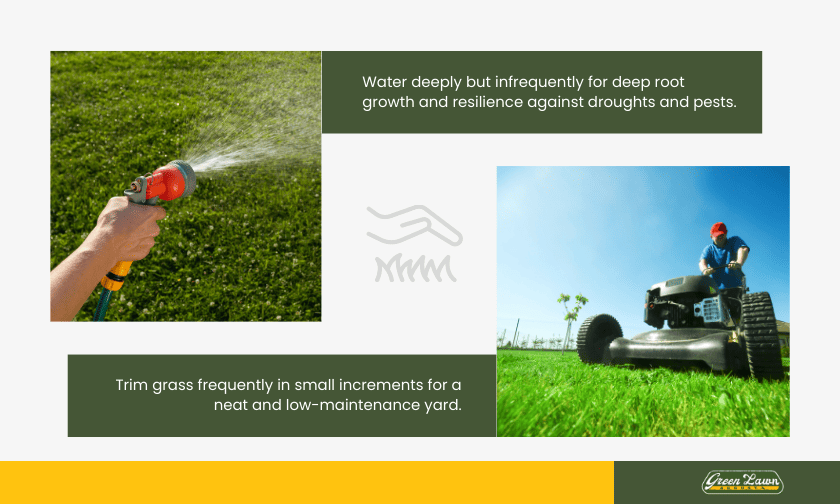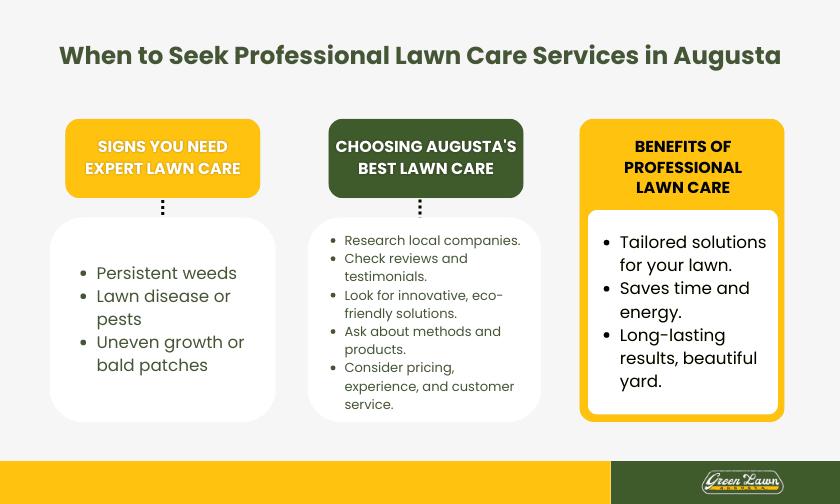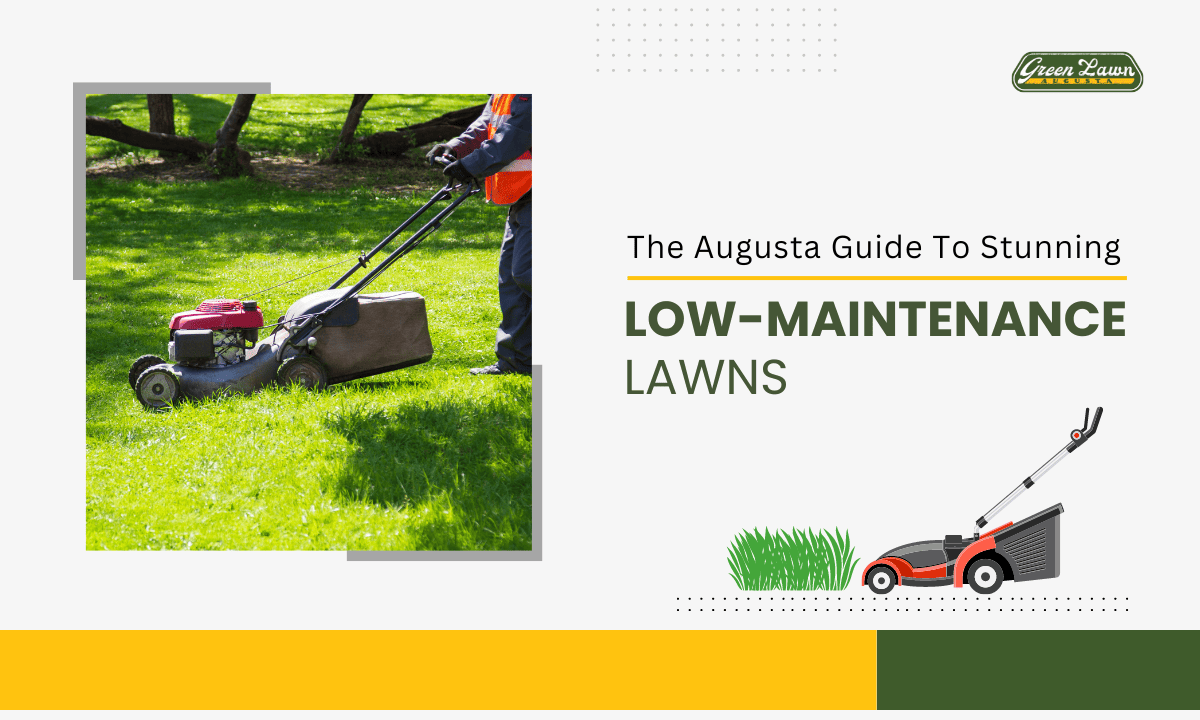Are you tired of spending hours tending to your yard just to see it looking less than perfect? Imagine having a stunning, low-maintenance grass that looks incredible and thrives.
This definitive guide is here to help you create and maintain a breathtaking landscape with minimal effort so that you can spend more time enjoying your outdoor space rather than laboring over it.
Table of Contents
ToggleKey Takeaways
- Understanding the weather and soil type is helpful for selecting low-maintenance grasses and plants.
- Smart watering practices, pest control, soil aeration, and fertilization are essential for maintaining a beautiful, low-maintenance lawn.
- Incorporating hardscaping elements, mulch, and ground covers can minimize maintenance tasks and add visual interest to the landscape.
- Seeking professional lawn care services can provide expert solutions tailored to unique situations and free up time for more enjoyable activities.
Climate Impact on Low-Maintenance Yards

As you dive into this guide, you’ll learn how soil type plays a significant role in lawn maintenance.
So, prepare to create the perfect, low-maintenance haven outside your door!
Understanding Local Weather
To help you make the best choices for your home, consider planting drought-tolerant grasses and incorporating native plants that can withstand the varying weather conditions.
Check out this table showcasing some popular options:
| Grass Type | Drought Tolerance | Maintenance Level |
| Bermuda Grass | High | Low |
| Zoysia Grass | Moderate-High | Low |
| Centipede Grass | Moderate | Low |
| St. Augustine Grass | Moderate | Medium |
Soil Type Influence on Yard Maintenance
Understanding your yard’s soil type is essential for creating that effortlessly beautiful outdoor space you desire without breaking your back on constant upkeep. Don’t worry if you’re not a soil expert – we’ve covered you with tips to determine the best grass and plant choices for your home.
To achieve a stunning low-maintenance turf, consider factors such as:
- Drought tolerant grasses Opting for species like Bermuda or Zoysia can help your lawn withstand the region’s hot summers without constant watering.
- Lawn aeration: Ensuring proper aeration will improve water penetration and nutrient absorption for healthier roots, leading to a less frequent need for fertilization.
Creating a Low-Maintenance Yard

Start by selecting grass types that require less maintenance, such as Bermuda or Zoysia.
Then, adopt essential watering practices specific to Augusta’s climate and learn how proper lawn mowing techniques can further reduce your maintenance efforts.
Selecting Grass Types
Choosing the right grass type can significantly reduce your workload, ensuring you’ll have a gorgeous yard without breaking a sweat. When selecting the perfect grass, consider climate, soil type, and sun exposure.
To make your decision easier, here are some top contenders known for their resilience and beauty:
- Zoysia Grass: This warm-season grass is drought tolerant and adapts well to various soil types. Zoysia’s dense growth pattern also aids in weed control.
- Bermuda Grass: Another excellent option, Bermuda grass is both drought-tolerant and wear-resistant. It thrives in sunny areas and offers impressive weed resistance.
- Fescue Grass: Fescue grass could be an ideal choice if your property has shady spots. This cool-season grass maintains its green color throughout most of the year.
Utilize materials like pavers or gravel pathways to create functional outdoor spaces while adding visual interest.
Similarly, mulch and ground covers work to suppress weeds and retain moisture, cutting back on watering needs even more so than with conventional lawns alone.
Essential Watering Practices
This section guides you through essential watering techniques to keep your grass looking its best while requiring minimal effort. Water deeply but infrequently, this encourages deep root growth and helps your turf becomes more resilient against droughts and pests.
Aim for about one inch of water per week during the growing season, either from rainfall or supplemental irrigation. If possible, invest in a smart irrigation system that can adjust the watering schedule based on weather conditions and soil moisture levels – this saves you time and conserves water resources. Remember to monitor your lawn’s health regularly; if you notice signs of stress, such as wilting or discoloration, adjust your watering practices accordingly.
Mowing for Reduced Maintenance
Believe it or not, adjusting your mowing habits can significantly reduce the time and effort needed to maintain a gorgeous, low-maintenance yard. Think of it like trimming your hair – you wouldn’t chop off large chunks at once but rather make small trims more frequently to keep everything looking neat and tidy. Similarly, by following some simple mowing tips, you can create a lush landscape that requires minimal upkeep.
For instance, avoid cutting more than one-third of the grass blade length at a time; this helps prevent stress on your lawn and promotes healthy growth.
To make your turf even more stunning with less work involved, consider implementing these four innovative ideas:
- Choose low-maintenance grass varieties that are well-suited for your climate, such as Zoysia or Bermuda grass.
- Incorporate native plants and flowers that require less water and care than non-native species.
- Opt for an automated irrigation system that will save time while ensuring proper watering for optimal growth.
- Explore modern landscaping designs that incorporate hardscapes (like patios or walkways) in combination with smaller areas of greenery.
Key Strategies for Low-Maintenance Care

Discover the secrets behind building drought-resistant and heat-tolerant yard, the vital role of soil aeration and fertilization, and efficient pest and weed control techniques.
With these key strategies, you’ll be well on your way to enjoying a beautiful lawn that requires less work!
Building Drought-Resistant and Heat-Tolerant Lawns
You’ll be amazed at how easy it is to create a drought-resistant, heat-tolerant lawn with the right approach and plant choices.
First, choose grass types naturally suited to Augusta’s climate, such as Bermuda or Zoysia grass. These warm-season grasses have excellent heat tolerance and can withstand periods of drought better than other varieties.
Additionally, consider incorporating native plants and groundcovers into your landscape design; these plants have adapted to the local environment over time and require less water and maintenance.
Proper watering techniques enhance your lawn’s resilience against drought and heat. Water deeply but infrequently, allowing the soil to dry out between watering sessions; this encourages deeper root growth, improving drought resistance.
Lastly, don’t forget the role of soil aeration and fertilization in creating a lush, low-maintenance lawn – but more on that in the next section!
Role of Soil Aeration and Fertilization
Did you know that proper soil aeration and fertilization can increase your lawn’s drought resistance by up to 25%? That’s right; these two innovative techniques create an environment where your grass can thrive despite water scarcity and high temperatures.
Soil aeration allows essential nutrients, water, and oxygen to penetrate deeper into the soil, supporting robust root growth for your grass. Meanwhile, appropriate fertilization provides the necessary nutrients for optimal growth and health, ensuring that your lawn stays lush and green even during challenging conditions.
To make the most of these methods, consider aerating your lawn at least once a year using a spike or plug aerator. This process breaks up compacted soil and creates small channels for better absorption of water and nutrients.
As for fertilization, go easy on it! Over-fertilizing can harm your lawn by making it more susceptible to pests, disease, and drought stress. Opt for slow-release organic fertilizers that feed your grass gradually while improving overall soil structure.
Efficient Pest and Weed Control Techniques
Efficient pest and weed control techniques are crucial for maintaining a healthy, vibrant lawn that can withstand drought and other challenges.
To stay ahead of the game, you’ll want to adopt innovative methods that protect your turf and save time and effort.
One such method is choosing selective herbicides that target specific weeds without harming your grass – a win-win for you and the environment!
Another cutting-edge strategy is utilizing biological controls, like introducing beneficial insects or microorganisms to help keep harmful pests in check.
You can also harness the power of technology by using smart irrigation systems that deliver water precisely where it’s needed, reducing runoff and minimizing weed growth.
Low-Maintenance Design
You can create a stunning low-maintenance design by incorporating native plants that thrive in your local climate. You can add hardscaping elements to reduce upkeep and use mulch and ground covers for weed control and moisture retention. By doing so, you’ll spend less time on yard work and more time enjoying your beautiful outdoor space.
So let’s dive into these key strategies to help you achieve the perfect low-maintenance landscape design.
Use of Native Plants
You’ll never guess, but using local native plants in your yard can actually make care a breeze – who would’ve thought? These indigenous species have adapted to the local climate and soil conditions, making them naturally low-maintenance. Plus, they often require less water and are more resistant to pests and diseases than non-native plants.
So not only will you be saving time and effort on upkeep, but you’ll also be contributing to the preservation of Augusta’s unique ecosystem by choosing these native beauties.
Incorporating Hardscaping to Reduce Maintenance
By incorporating hardscaping elements into your landscape, you’ll reduce maintenance tasks and create an elegant outdoor space that complements the natural beauty of native plants. Hardscaping refers to the non-living components of a landscape, such as patios, walkways, and retaining walls. These features add structure and visual interest to your yard while reducing the grass and other high-maintenance plantings you need to care for.
| Stunning Walkways | Relaxing Patios | Eye-catching Retaining Walls |
| Pave a pathway through a lush garden with native plants | Create an inviting gathering space surrounded by natural beauty | Showcase terraced gardens filled with vibrant Augusta flora |
| Use materials like brick or stone for a timeless look | Add comfortable seating and ambient lighting for cozy evenings | Incorporate local stones or boulders for added texture |
| Design intricate patterns or simple lines for visual appeal | Enhance with potted plants or built-in planters | Build functional steps or seating areas within the wall |
Experiment with different materials and designs that reflect your unique style while embracing innovation in sustainable landscaping. With well-planned hardscaping in place, you’ll spend less time mowing, watering, and fertilizing—and more time enjoying the serene atmosphere of your low-maintenance lawn.
Advantages of Mulch and Ground Covers
So, you think you’ve mastered the art of hardscaping, huh? Well, let’s not get too comfortable just yet – it’s time to dive into the world of mulch and ground covers for that extra eco-friendly touch in your outdoor haven.
Let’s explore some key advantages:
- Weed suppression: Mulch and ground cover act as a natural barrier against those pesky weeds that love to invade your garden space. Blocking sunlight prevents weed seeds from germinating and reduces the need for constant weeding – giving you more time to enjoy the fruits of your labor.
- Moisture retention: Both mulch and ground covers have excellent water-holding abilities, which means they lock in moisture around plant roots, reducing evaporation rates. This helps keep your plants hydrated during the hot summer months and translates into less frequent watering on your part.
- Soil enrichment: As organic mulches decompose over time, they release essential nutrients into the soil, improving overall soil structure. This leads to healthier plants with stronger root systems that withstand pests and diseases better.
When to Seek Professional Care

As you identify your need for expert assistance, consider factors such as time constraints, specific issues, and desired results.
For comprehensive lawn care solutions tailored to Augusta’s unique climate, explore our professional lawn care services Augusta, GA. Our team is dedicated to keeping your lawn healthy and vibrant year-round.
Frequently Asked Questions
What is the most low-maintenance lawn?
Zoysia grass is the most low-maintenance lawn option.
How can I make my yard easier to maintain?
To make your yard easier to maintain, choose low-maintenance plants and grasses, use a mulch to suppress weeds, and install automatic irrigation systems.
How can I make my yard look better without grass
To make your yard look better without grass, use alternative ground covers like gravel, wood chips, or artificial turf, incorporating plants and hardscape features.
What is the best grass that repairs itself?
The best self-repairing grass is Kentucky Bluegrass, which has rhizomes that help fill bare spots.
How do I bring my yard back to life?
To bring your yard back to life, start by aerating the soil, reseeding bare spots, fertilizing, and proper watering.
How can I get my lawn back to green cheaply?
To get your lawn back to green cheaply, focus on proper watering, mowing, and fertilizing, and consider overseeding with a more resilient grass variety.

